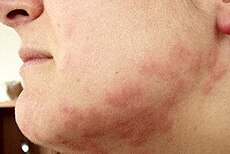Bed bug infestation
From Wikipedia, the free encyclopedia
| Bed bug bites | |
|---|---|
| Classification and external resources | |
 Typical bed bug bites. | |
A Bed bug can individually and collectively cause a number of health effects including skin rashes, psychological effects and allergic symptoms. Bed bug bites or cimicosis may lead to a range of skin manifestations from no visible effects to prominent blisters.Diagnosis involves both finding bed bugs and the occurrence of compatible symptoms.Treatment involves the elimination of the insect but is otherwise symptomatic.
Because infestation of human habitats has been on the increase in developed countries, bed bug bites and related conditions have been on the rise as well, since the 1980s–1990s.The exact causes of this resurgence remain unclear; it is variously ascribed to greater foreign travel, more frequent exchange of second-hand furnishings among homes, a greater focus on control of other pests resulting in neglect of bed bug countermeasures, and increasing resistance to pesticides.Bed bugs have been known human parasites for thousands of years
Signs and Symptoms
Individual responses to bites vary, ranging from no visible effect (in about 20–70%) to small macular spots, prominent weals and bullae formation along with intense inthching that may last several days. A central hemorragic spot may also occur due to the release of anticoagulantsin the saliva.
Symptoms may not appear until some days after the bites have occurred. Reactions often become more brisk after multiple bites due to possible sensitization to the salivary proteins of the bed bug. The skin reaction usually occurs in the area of the bite which is most commonly the arms, shoulders and legs as they are more frequently exposed at night.Numerous bites may lead to an erythematous rash or urticaria.
[edit]psychological
Serious infestations and chronic attacks can cause anxiety, stress, and insomia. Development of refractory delusional parasitosis is possible, as a person develops an overwhelming obsession with bed bugs.
[edit]Other
A number of other symptoms may occur from either the bite of the bed bugs or from their exposure. Anaphylaxis from the injection of serum and other nonspecific proteins has been rarely documented. Due to each bite taking a tiny amount of blood, chronic or severe infestation may lead to anemia. Bacterial skin infection may occur due to skin break down from scratching.Systemic poisoning may occur if the bites are numerous.Exposure to bed bugs may trigger an asthma attack via the effects of airborne allergens although evidence of this association is limited. There is no evidence that bed bugs transmit infectious diseases even though they appear physically capable of carrying patogens and this possibility has been investigated. The bite itself may be painful thus resulting in poor sleep and worse work performance.
[edit]Cause
BED BUG
Bed bug bites are caused by bed bugs primarily of two species Cimex lectularius (the common bed bug) and Cimex hemipterus.Infestation is rarely due to a lack of hygiene. These insects feed exclusively on blood and may survive a year without eating.They are attracted by body warmth and carbon dioxide. Transfer to new places is usually in the personal effects of the human they feed upon.
[edit]Diagnosis
A definitive diagnosis of health effects due to bed bugs requires a search for and finding of the insect in the sleeping environment as symptoms are not sufficiently specific. Other possible conditions with which these conditions can be confused include: scabies, allergic reactions, mosquito bites,spider bites, chicken pox and bacterial skin infections. Bed bugs classically form a line of bites colloquially referred to as "breakfast, lunch, and dinner" and rarely feed in the armpit or behind the knee which may help differentiate it from other biting insects. If the number in a house is large a pungent sweet odor may be described.
[edit]Treatment
Treatment requires keeping the person from being repeatedly bitten and possible symptomatic use of antihistamines and corticosteroids (either topically or systemically). There however is no evidence that medications improve outcomes and symptoms usually resolve without treatment in 1–2 weeks.
Avoiding repeated bites can be difficult, since it usually requires eradicating bed bugs from a home or workplace; eradication frequently requires a combination of pesticides and non pesticide approaches.Pesticides that have historically been found to be effective include:pyrethroids, dichlorvos and mamathion. Resistance to pesticides has increased significantly over time and there are concerns of negative health effects from their usage. Mechanical approaches such as vacuuming up the insects and heat treating or wrapping mattresses have been recommended. Diatomaceous Earth can be used to kill existing bugs though its effects may take several weeks, it can also be used to prevent a re-infestation.
BE ALERT OF BED BUGS....BEFORE IT KILLS YOU!!



